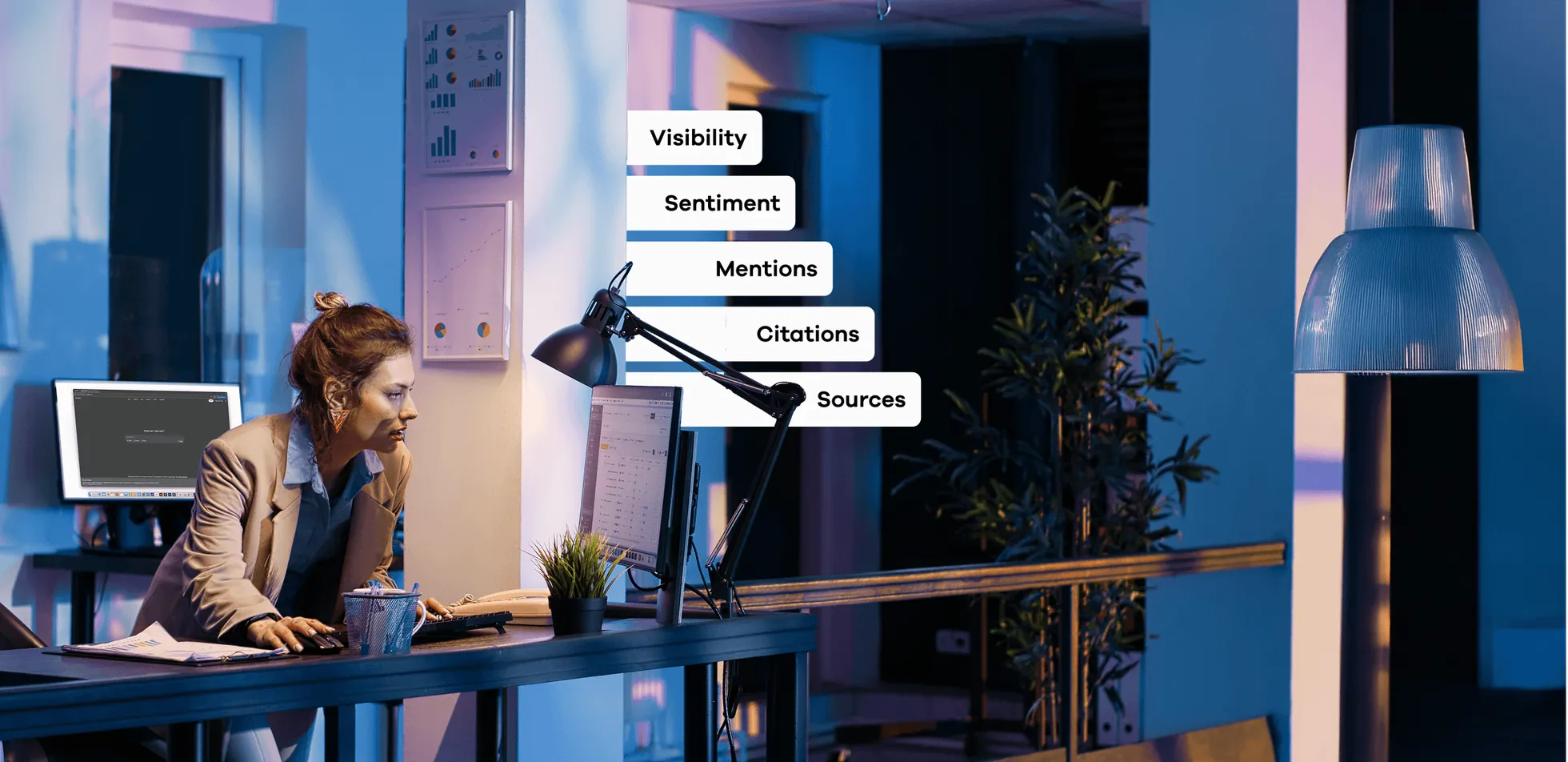
The Future of SEO: Predictions and Trends to Watch Out For

Divashree
September 25, 2023
Stay ahead of the curve in the ever-evolving world of SEO with our insightful article on future predictions and key trends to keep an eye on.

In the ever-evolving digital landscape, the future of Search Engine Optimization (SEO) promises to be dynamic and transformative. As we venture into this new era, several predictions and trends are poised to reshape the way businesses approach online visibility and engagement. With search engines becoming increasingly sophisticated and user expectations evolving, the strategies that govern SEO are set to undergo significant shifts.
User intent and semantic search are expected to take center stage. Search engines are refining their ability to understand the context behind user queries, transcending mere keyword matching. This trend emphasizes the importance of producing content that aligns with users' underlying needs and intentions.
Moreover, the user experience (UX) will continue to play a pivotal role. Core Web Vitals, which gauge website loading speed, interactivity, and visual stability, are not just metrics but determinants of search engine rankings. This highlights the growing significance of delivering seamless and fast browsing experiences to visitors.
As mobile devices dominate online interactions, mobile-first and even mobile-only indexing are projected to become standard practices. Websites must be optimized for mobile devices to ensure optimal performance and visibility in search results.
Artificial Intelligence (AI) and automation are set to revolutionize SEO practices. AI-powered tools will streamline tasks like content creation and optimization, while automation will free up marketers to focus on strategic initiatives.
In this landscape, keeping up with the evolving SEO environment will be crucial. Businesses must adapt to changes in user behavior, search engine algorithms, and emerging technologies. By staying informed and embracing these anticipated trends, brands can position themselves to thrive in the future SEO landscape.
Here are some of the trends,
User Intent and Semantic Search
User intent and semantic search are critical concepts in modern SEO strategies. User intent refers to the underlying purpose or goal that a user has when entering a search query. Businesses must understand these intentions to deliver relevant content that fulfills users' needs effectively. Semantic search, on the other hand, involves search engines' ability to comprehend the contextual meaning of search queries and web content, going beyond traditional keyword matching.
By focusing on user intent, SEO practitioners or SEO agencies can tailor their content to address specific user needs, resulting in higher engagement and conversions. This approach requires in-depth keyword research to identify not only the most relevant keywords but also variations that capture different facets of user intent to improve customer experience.
Semantic search leverages natural language processing and artificial intelligence to comprehend the relationships between words, enabling search engines to offer more accurate results. Optimizing for semantic search involves using diverse vocabulary, providing comprehensive information, and structuring data for easier interpretation by search engines.
In combination, understanding user intent and optimizing for semantic search can enhance a website's visibility in search results. By aligning content with what users seek and ensuring that it's semantically rich, businesses can improve their chances of ranking well, attracting relevant traffic, and ultimately achieving their SEO goals.
Core Web Vitals and User Experience
Core Web Vitals have emerged as a critical factor in SEO due to their strong influence on user experience. Comprising metrics like loading performance, interactivity, and visual stability, Core Web Vitals offer insights into how smoothly and quickly a webpage loads and becomes interactive, while also ensuring that its visual elements remain steady during user interaction. Google's integration of Core Web Vitals into its ranking algorithm underscores the significance of user-centric web experiences.
 Source: Searchengineland
Source: SearchenginelandUser experience, a pivotal aspect of SEO, centers on visitors' perceptions and interactions with a website. Positive user experiences result in longer browsing sessions, reduced bounce rates, and increased conversions. Core Web Vitals, being indicators of site responsiveness and usability, directly impact user engagement and satisfaction.
Websites that prioritize Core Web Vitals optimization tend to offer faster loading times, seamless interactivity, and smoother visual experiences. Such enhancements lead to improved user engagement and retention, positively influencing search rankings. To leverage Core Web Vitals for SEO, businesses should focus on technical optimizations like efficient coding, optimizing images and scripts, and utilizing content distribution networks. By harmonizing Core Web Vitals improvements to enhance user experiences, websites can bolster both their search visibility and user satisfaction.
Mobile-First and Mobile-Only Indexing
Mobile-first and Mobile-only indexing are crucial concepts in modern SEO strategies, given the increasing dominance of mobile devices in online browsing. Mobile-first indexing signifies Google's shift towards predominantly using the mobile version of a website's content for indexing and ranking. This approach acknowledges that more users access the internet via mobile devices, emphasizing the need for mobile-friendly and responsive design.
Mobile-only indexing takes this concept a step further by considering only the mobile version of a website's content for indexing and ranking, especially for websites that have separate mobile and desktop versions. This approach reinforces the importance of optimizing the mobile user experience, as Google evaluates a site's mobile content to determine its relevance and ranking in search results.
To excel in these indexing strategies, businesses should prioritize responsive design, ensure that mobile content is as comprehensive as desktop content, and focus on mobile site speed and usability. Mobile-friendly design enhances user experiences, reduces bounce rates, and positively impacts SEO rankings.
Incorporating Mobile-First and Mobile-Only indexing into SEO practices acknowledges the growing significance of mobile browsing, aligning websites with user preferences and search engine requirements. By optimizing for mobile, businesses can secure higher visibility and engagement in search results, catering to the evolving habits of online users.
If you're considering these strategies, it's worth hiring a React developer to help create a responsive and user-friendly mobile experience for your website.
Voice and Visual Search
Voice and visual search are transformative trends reshaping the landscape of SEO. Voice search involves using spoken queries with virtual assistants like Siri or Alexa, while visual search allows users to search using images or camera input.
Voice search optimization is crucial as more people use voice commands on mobile devices and smart speakers. It requires conversational, natural language content that addresses user questions concisely. Long-tail keywords become vital, reflecting how people speak.
Visual search optimization caters to the growing popularity of platforms like Google Lens and Pinterest Lens. It requires optimizing image alt text, using high-quality images, and structuring data to enhance search engine understanding.
Both voice and visual search emphasize delivering precise, context-rich answers. SEO strategies should incorporate schema markup, local SEO, and ensuring mobile-friendliness. Brands that embrace these trends can capture new types of user interactions, enhancing their online visibility and user engagement.
Incorporating voice and visual search into SEO strategies acknowledges evolving user behavior and search technologies. By optimizing for these modes, businesses can stand out in a dynamic search landscape, catering to users who prefer interactive and visually oriented search experiences.
 Source: Codecondo
Source: CodecondoArtificial Intelligence and Automation
Artificial Intelligence (AI) and automation are revolutionizing the field of SEO, introducing efficiency, precision, and scalability to various tasks. AI-powered tools analyze vast amounts of data, enabling marketers to identify trends, patterns, and insights that inform strategic decisions. Automation streamlines repetitive tasks, freeing up time for more strategic endeavors.
AI's predictive analytics assist in keyword research, content optimization, and competitor analysis, enhancing the accuracy of targeting and optimizing search results. Natural language processing (NLP) aids in understanding user intent and tailoring content to better match search queries.
Automation handles tasks like reporting, link building, and social media posting, ensuring consistent and timely execution. Chatbots and AI -powered virtual assistants offer personalized user experiences and assist visitors in real time, enhancing engagement.
To leverage AI and automation for SEO, marketers should focus on selecting appropriate AI SEO tools, refining data quality, and staying updated on algorithm changes. Balancing automation with human expertise remains crucial to maintaining authenticity and relevance.
Incorporating AI and automation into SEO strategies signifies an embrace of innovative technologies that refine decision-making, enhance user experiences, and improve overall search engine performance. Try to take advantage of ux research tools to collect user insights. As the digital landscape evolves, these tools empower businesses to stay competitive and adaptable in their approach to SEO.
E-A-T and Expertise-Driven Content
E-A-T, which stands for Expertise, Authoritativeness, and Trustworthiness, is a crucial concept in SEO that Google uses to assess the quality and credibility of web content. E-A-T plays a significant role in determining search rankings, particularly for topics that impact users' well-being, such as health, finance, and legal matters.
 Source: WordStream
Source: WordStreamExpertise-driven content involves creating high-quality content that demonstrates subject matter expertise, authority, and trustworthiness. Such content not only meets users' informational needs but also aligns with E-A-T principles. To excel in E-A-T, businesses should showcase the credentials and expertise of content creators, use authoritative sources, and provide accurate and well-researched information.
Guest posting is a crucial strategy for publishing expertise-driven content. To get pitches accepted, use an AI email generator for crafting engaging outreach emails.
Demonstrating E-A-T involves establishing the credentials of authors, obtaining external validations, and fostering a positive online reputation. Quality backlinks from reputable sources further enhance the perception of authority and trustworthiness.
By emphasizing E-A-T in content creation, websites can improve search engine rankings, build credibility, and enhance user satisfaction. Expertise-driven content ensures that users receive accurate and valuable information, enhancing the overall user experience and building trust in the brand.
Incorporating E-A-T principles into SEO strategies is essential for building a solid online presence, particularly for topics where expertise matters. When partnering with a B2B SEO agency and consistently delivering reliable and authoritative content, businesses can not only rank higher in search results but also establish themselves as trusted resources in their respective industries.
Featured Snippets and Zero-Click Searches
Featured snippets and zero-click searches are significant trends in the world of SEO, reshaping how users interact with search results and influencing content optimization strategies.
Featured snippets are concise, direct answers that Google displays at the top of search results. They provide users with immediate information, often leading to increased visibility for the website featured in the snippet. Optimizing for featured snippets requires providing clear, structured answers to common user questions.
Zero-click searches occur when users find the information they need directly within search results, without clicking through to a website. This trend is driven by featured snippets, knowledge panels, and other rich results. While they offer quick answers, they can reduce website traffic, challenging traditional click-through rates.
To leverage featured snippets and address zero-click searches, content should be structured to address common queries succinctly. Utilizing schema markup and structured data helps search engines understand content better and present it in rich snippets. Creating detailed and comprehensive content that encourages users to explore further can also counter the impact of zero-click searches.
Incorporating strategies to capture featured snippets and address zero-click searches can enhance a website's visibility, authority, and engagement in search results. Balancing quick answers with enticing content that encourages exploration can help websites adapt to changing user behaviors while maintaining a strong online presence.
Video and Rich Media SEO
Video and rich media content have become integral to modern SEO strategies, offering dynamic ways to engage audiences and enhance search visibility. Videos are highly engaging and can convey complex information quickly, making them a valuable tool for capturing user attention.
Video SEO involves optimizing video content for search engines. This includes using relevant keywords in titles, descriptions, and tags, creating compelling thumbnails, and providing accurate transcripts. Hosting videos on platforms like YouTube can also boost visibility due to their search engine integration.
Rich media SEO encompasses a wider range of interactive content, including images, infographics, podcasts, webinars, and interactive web elements. Optimizing rich media involves using descriptive filenames, alt text for images, and structured data to help search engines understand the content's context.
Search engines increasingly prioritize mixed media content in search results. Videos and rich media elements often appear in featured snippets and knowledge panels, offering users diverse ways to access information. Websites that incorporate these elements can enjoy higher engagement, longer dwell times, and improved rankings.
Embracing video and rich media SEO strategies caters to diverse user preferences and elevates the overall user experience. By providing valuable and engaging content in various formats, businesses can effectively reach wider audiences and stand out in the competitive online landscape.
Local and Hyperlocal SEO
Local and hyperlocal SEO are essential strategies for businesses aiming to attract nearby customers and improve their online visibility within specific geographic regions.
Local SEO focuses on optimizing a website to appear in local search results, making it easier for users to find businesses, products, and services in their vicinity. This involves setting up and optimizing Google My Business profiles, ensuring accurate business information, managing online reviews, and utilizing location-specific keywords.
Hyperlocal SEO takes local optimization a step further by targeting very specific neighborhoods or even individual streets within a city. This strategy involves tailoring content to address hyperlocal concerns, participating in local events, and engaging with local communities on social media.
Both local and hyperlocal SEO are crucial for businesses with physical locations or those serving specific geographic markets. These strategies help businesses appear in map results, local pack listings, and location-based searches, driving foot traffic and conversions.
By integrating local and hyperlocal SEO practices, businesses can capitalize on location-based intent, providing users with relevant, timely information about nearby offerings. This approach enhances user experience, builds brand loyalty, and increases the chances of converting online interactions into offline sales.
Search Engine Diversification
Search engine diversification refers to the strategic approach of expanding a website's online presence across multiple search engines, rather than relying solely on a single platform, typically Google. This approach aims to mitigate risks associated with algorithm changes, maintain visibility across various user preferences, and tap into different user demographics.
While Google remains the dominant search engine, diversification recognizes the evolving digital landscape and the emergence of alternative search platforms like Bing, Yahoo, DuckDuckGo, and more. Each search engine has its user base and ranking algorithms, making diversification a means to reach diverse audiences.
By optimizing for multiple search engines, businesses can safeguard against sudden ranking drops due to algorithm updates on a single platform. It also allows them to leverage platform-specific features and audiences. This strategy is particularly relevant for international markets where specific search engines hold tremendous popularity.
To diversify, optimize content for various search engines by considering their unique requirements and best practices. Research user preferences for each platform and adjust strategies accordingly. Monitoring performance and adjusting tactics based on each engine's analytics can refine the approach over time.
Search engine diversification acknowledges the importance of adapting to changing user behaviors and preferences. By broadening a website's search engine reach, businesses can increase their resilience, visibility, and overall online success.
In conclusion, the future of SEO promises a fascinating evolution that demands adaptability and innovation from businesses and digital marketers. As technology and user behaviors continue to evolve, the landscape of search engine optimization will undoubtedly undergo significant transformations.
Conclusion
The shift towards user intent and semantic search signifies a departure from traditional keyword-centric strategies. Brands that invest in understanding their audience's intentions and crafting content that addresses these needs will likely gain a competitive edge.
User experience is no longer a mere consideration but a crucial ranking factor. The emphasis on Core Web Vitals and seamless browsing experiences underscores the importance of prioritizing user satisfaction.
The integration of AI and automation into SEO workflows presents both opportunities and challenges. While these technologies can streamline processes and provide valuable insights, maintaining a balance between automation and human touch will be vital to ensure authenticity and personalization.
As search engines continue to refine their algorithms and new platforms emerge, diversifying SEO strategies to reach audiences across various media will be essential. Adapting to the preferences of each search engine and audience demographic will be the key to staying visible and relevant.
In the dynamic landscape of SEO, continuous learning and experimentation will be paramount. Brands that keep abreast of emerging trends, embrace new technologies, and optimize their strategies accordingly will be better positioned to thrive in the ever-evolving digital ecosystem. The future of SEO holds both challenges and opportunities, making it an exciting journey for those who are prepared to navigate its twists and turns.
Related blog posts

5 LLM Visibility Metrics You Should Track in 2026
SEO is now both about ranking in search engines and being visible in LLMs. We give you five visibility metrics every SEO should track in 2026.
3 December 2025Is LLM Tracking Relevant for You?
LLM tracking is not just for SEOs. It is also relevant for content teams, agencies, marketing leadership, and communication teams. Learn why here.
26 November 2025
How to Find the Best Prompts to Track for AI Visibility
Do you want to start tracking prompts to optimize your AI visibility? We give you seven practical ways to identify relevant prompts to track in LLMs.
9 November 2025
